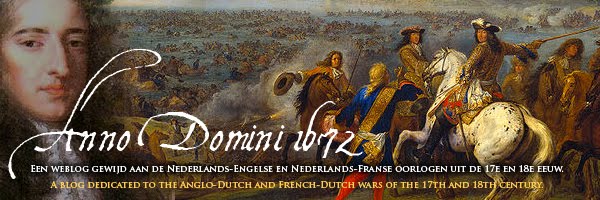
Summary
A battle like the one at Seneffe, must be seen in the light of it's time and age and one should realise that battles in the 16th and 17th century took a different position in warfare than today. Battles rarely where the outcome of a plan, and to characterise this, another word for battle at that time was 'occasie' or 'occasion'.
For weeks and even months enemies tried to find and encircle each other, just to find the right time and place and this is the way the battle of Seneffe started. The strategic value of these battle was zero or at least problematic. On the other hand great value was attached to appearences like captured kettke drums, flags and colours, and most importantly 'who kept the field', after the battle.
The allied army of Willam III, numbered around 60.000 men: 30.000 Dutch troops, about 12.000 Spanish of different nationalities, and 20.000 Imperial troops. The Spanish troops were commanded by the Monterey, the stadholder of the Spanish Netherlands, and the Imperialists were under De Souches. Especially de Souches caused a lot of problems because he had secret orders not to interfere in battle.
The French, numbering about 45.000 men, were under the great Condé, and were in the minority. Conde had a fortified camp behind the Pieton river. William himself tried to convince his commanders to go to battle, but this was refused so the army marched south to the French border. The allies moved a bit more to the French lines to scout Condé's position but somewhat in a hurry the army broke camp and went south on the 11th.
This turned out to be a rather bad idea: marching under the eye of the enemy, especially Condé, through rough terrain was asking for trouble. And trouble came.
Condé found out about the plans of the allied army already on the 10th. On the 10th he already moved cavalry and infantry over the river Pieton, and the next day he moved to a position to watch the allied army. He immediatly ordered an attack to the rear guard of the allies, with cavarly, infantry and six artillery pieces under de Montal. Condé himself commanded the Maison du Roi and crossed the river up north.
This was noticed by the prince of Veaudemont, a man from Lorraine in Spanish service and his dragoons, who asked William for reinforcements and three bataillions Dutch went to Seneffe to defend the village. Near Seneffe the first phase of the battle started and the allies were driven out the village which was very difficult to defend. At least three dutch bataillons were beaten, 'Young' Prince Maurice was captured, but Montal was wounded himself as well. The French pushed on, causing a rout of the allies. In a position north of Condé, general Fourilles moved his cavalry, smashed the dutch Nassau Friesland regiment who were guarding the baggage train and who fled into the baggage train. The French followed them and paid their attention to the baggage and started looting.
Condé started to push on to the allied rear guard, consisting of 16 squadrons under the marquis of Assentar, the duke of Villa Hermosa and only one bataillion of infantry under Beaumont. Monterey took the rest of the infantry to the avant-garde, 'took a wrong turn' and turned up the next day after the battle.
The van Weede brigade, about 12 bataillions, fortunatly started covering the retreat of the Spanish, and both sides were in confusion and new lines started to appear after the troops were rallied.
The French attacked again: on the right Luxembourg, in the centre Fourilles and on the left Condé with the Maison du Roi. Near the convent of St Nicolas du Bois a fierce battle started, the decond part of the battle of Seneffe: Condé managed to break through the center, the French infantry arrived and attacked from the east and despite the personal courage of William the allied were pushed back again. Amongst the dead were Col. Aylva and Spanish commander de Assentar. Up to now, about 45 allied squadrons and 18 batallions were beaten.
But still, three Dutch brigades were intact plus some cavalry. Also, the Imperial troops were not involved in the battle, either through unwillingness as dutch writers state, or the actions of french general St Clas, who was snet out to Condé to harras the avant-garde.
William managed to make a new defensive line near the village of Fay, with the dutch on the right in the East and the imperialist on the left. Also the artillery was deployed.
Again fierce fighting started. Fay was well defendable position, skrimishers were deployed in the hedges and cavalry was used a a mobile defense by the allies. The French attacked the village but failed to move on. Luxembourg managed to near the artillery but was pushed back by a counter attack. He was himself attacked by Fariaux, the defender of Maastricht.
On the other flank, near Hestre, the dutch were pushed back by Navailles, but he again was attacked by John Maurice 'The Brazilian'. Fighting continues until dark, all the French attacks were repulsed. After midnight Condé ordered his troops to leave the field.
Historians agree that the battle was one of the bloodiest in the 17th century and it is estimated that both sides recieved about 3000 casualties. The French claim about 3.500 prisoners and the capture of at least 107 colours, plus 40 pontoons and a large part of the baggage train.
The allies state that they left the field two hours after the french, and that they reached their marching target. The last attack of the French was beaten, but the attack on France itself had to be postponed. The batte therefore was undecided.
Original text (c) Ons Leger / Translation (c) rampjaar.blogspot.com




Geen opmerkingen:
Een reactie posten
Opmerking: Alleen leden van deze blog kunnen een reactie posten.